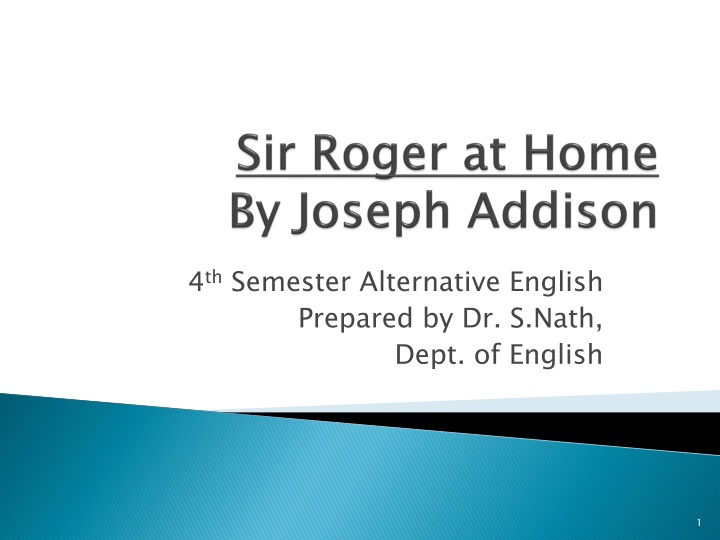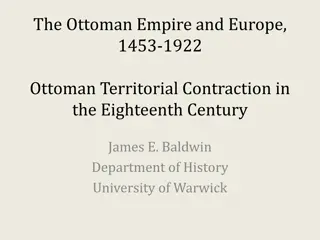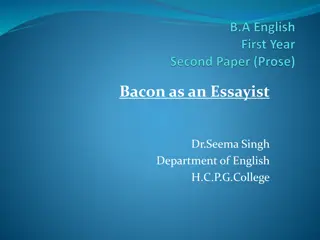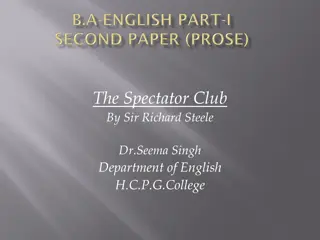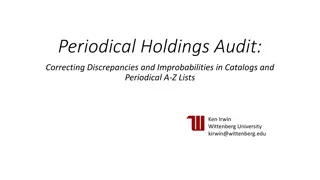Exploring the Periodical Essays of the 18th Century through Sir Roger at Home
The emergence of periodical essays in the 18th century, particularly through publications like The Tatlar and The Spectator, paved the way for a new literary form. This genre featured single-theme essays rather than a mix of information. Sir Roger, a beloved character from The Spectator created by Addison, represents the epitome of a generous and kind-hearted landed gentry. The author recounts his experience staying at Sir Roger's estate in Worcestershire and illustrates Sir Roger's endearing relationships with his domestic helpers, whom he treats as family members.
Uploaded on Sep 13, 2024 | 2 Views
Download Presentation

Please find below an Image/Link to download the presentation.
The content on the website is provided AS IS for your information and personal use only. It may not be sold, licensed, or shared on other websites without obtaining consent from the author.If you encounter any issues during the download, it is possible that the publisher has removed the file from their server.
You are allowed to download the files provided on this website for personal or commercial use, subject to the condition that they are used lawfully. All files are the property of their respective owners.
The content on the website is provided AS IS for your information and personal use only. It may not be sold, licensed, or shared on other websites without obtaining consent from the author.
E N D
Presentation Transcript
4thSemester Alternative English Prepared by Dr. S.Nath, Dept. of English 1
The periodical essay was a new literary form that emerged during the early part of the 18th century. These essays appeared in affordable publications that came out regularly, usually two or three times a week. They did not consist of medley of information and news, but comprised of a single essay usually on specific theme. 2
The Tatlar and The Spectator were the most popular and influential periodicals of the time The Tatlar was started by Richard Steele in April 1709 appearing three times a week until January 1711 Two months after The Tatlar ceased publication, Addison and Steele launched the brilliant periodical The Spectator which continued till December, 1712. 3
The essay Sir Roger at Home is taken from the periodical The Spectator Addison created an imaginary club called Spectator Club whose members extolled the authors own ideas about society These members included representatives of commerce, the army, the town and the county gentry 4
Sir Roger is the most popular and lovable character of the club created by Addison. He was a baronet of Worcestershire and was meant to represent a typical landed gentry On account of his cheerful nature and kind disposition, he was loved by all. He was a humourist and his virtues and imperfections were tinged with a certain extravagance which made him more agreeable. 5
The author begins by remarking that since he had often been invited to spend a month or two with Sir Roger in his country house, he decided to accompany him the previous week to Worcestershire. Sir Roger had been a perfect host and gave the author privacy and freedom to spend his time the way he wanted 6
The author describes Sir Rogers family . Sir Roger never married and considered his domestic helpers as family members. Sir Roger is described as the best master in the world as he is highly sympathetic, considerate and compassionate towards his servants The author refers to the servants as sober and staid ( solemn and respectable) persons because of their appearance and behaviour. They have never left their master and have grown old with him 7
Sir Rogers valet( personal attendant) looked like his brother, his butler was grey haired, his groom ( one who looked after horses) was one of the gravest man that the author saw and the coachman looked like a member of the legislature. Even Sir Roger s dog had grown old but was looked after with great care and tenderness though he was currently useless. 8
The author describes the mutual love and respect between Sir Roger and his servants Sir Roger s visit to his country house brought great cheer and happiness to his servants. Sir Roger also enquired about the affairs of the house with a mixture of the father and the master. His humanity and good nature endeared him to all. Any sign of sickness or discomfort in him brought concern to his servants. 9
The author mentions that Sir Roger put him under the care of his butler who was a prudent man and was always desirous of pleasing him But the author s chief companion was the chaplain who had lived in the family as a relation rather than a dependant The chaplain was a person of good sense and heartily loved Sir Roger who held him in high esteem. 10
The author describes Sir Roger character and remarks that his personality was marked by a certain extravagance which distinguished him from the rest. And because of this character trait, Sir Roger s conversation were highly agreeable. The author then describes his conversation with him when Sir Roger expressed his appreciation of his Chaplain who was recommended by his University friend when Sir Roger had requested him for a clergyman who was a man of plain sense than much learning, of a good aspect, a clear voice, a sociable temper and a man who understood a little of backgammon 11
Sir Roger then narrated his experience with the chaplain( who had been living with him for thirty years )to the author. The chaplain possessed all the qualities that were required of him and since he valued him so much, Sir Roger had settled upon him a good annuity for life. Sir Roger also mentioned how the chaplain was always concerned for his parishioners and there had never been in the parish a law-suit since his arrival. 12
Sir Roger also mentioned the author that when the chaplain had first settled with him, he had presented him a compilation of good sermons which had been printed in English and requested him to pronounce one of them in the pulpit every Sunday. Accordingly, the chaplain had summarized them into such a series that they followed one another naturally and made a continuous system of practical divinity, 13
The author expressed his satisfaction of the chaplain when he saw him at the pulpit He endorsed Sir Roger s insistence upon the qualifications of a good aspect and a clear voice for a clergyman. For it were these qualities of the chaplain which charmed the author when he delivered his sermon. The author makes a beautiful comparison when he remarks that a sermon delivered in this manner ii like a poem recited by a graceful actor. 14
The author concludes by recommending that all country clergymen should follow this example . Instead of wasting their energies on composing difficult compositions of their own, the author advises that they should engage their qualities in delivering sermons penned by greater masters. This would not only be easier for them for would be more useful to the people. 15
Describe the authors experience at Sir Roger s house. Whom does the author refer to as Sir Roger s family? Why does he call them as sober and staid persons ? Describe Sir Roger s family and his relation with them. Describe the qualities necessary for a chaplain according to Sir Roger. Discuss the character of Sir Roger. Discuss Addison as a periodical essayist. 16
